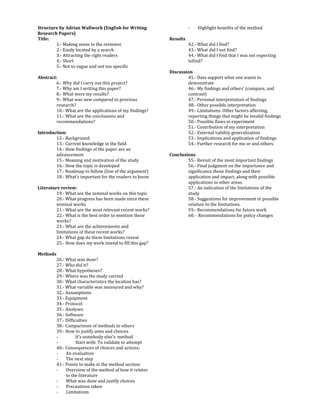Structure of an_article
- 1. Structure by Adrian Wallwork (English for Writing - Highlight benefits of the method Research Papers) Title: Results 1.- Making sense to the reviewer 42.- What did I find? 2.- Easily located by a search 43.- What did I not find? 3.- Attracting the right readers 44.- What did I find that I was not expecting 4.- Short tofind? 5.- Not to vague and not too specific Discussion Abstract: 45.- Data support what one wants to 6.- Why did I carry out this project? demonstrate 7.- Why am I writing this paper? 46.- My findings and othersâ (compare, and 8.- What were my results? contrast) 9.- What was new compared to previous 47.- Personal interpretation of findings research? 48.- Other possible interpretation 10.- What are the applications of my findings? 49.- Limitations: Other factors affecting, 11.- What are the conclusions and reporting things that might be invalid findings recommendations? 50.- Possible flaws in experiment 51.- Contribution of my interpretation Introduction: 52.- External validity generalization 12.- Background 53.- Implications and application of findings 13.- Current knowledge in the field 54.- Further research for me or and others. 14.- How findings of the paper are an advancement Conclusions 15.- Meaning and motivation of the study 55.- Revisit of the most important findings 16.- How the topic is developed 56.- Final judgment on the importance and 17.- Roadmap to follow (line of the argument) significance those findings and their 18.- Whatâs important for the readers to know application and impact, along with possible applications to other areas. Literature review: 57.- An indication of the limitations of the 19.- What are the seminal works on this topic study 20.- What progress has been made since these 58.- Suggestions for improvement in possible seminal works relation to the limitations. 21.- What are the most relevant recent works? 59.- Recommendations for future work 22.- What is the best order to mention these 60.- Recommendations for policy changes works? 23.- What are the achievements and limitations of these recent works? 24.- What gap do these limitations reveal 25.- How does my work intend to fill this gap? Methods 26.- What was done? 27.- Who did it? 28.- What hypotheses? 29.- Where was the study carried 30.- What characteristics the location has? 31.- What variable was measured and why? 32.- Assumptions 33.- Equipment 34.- Protocol 35.- Analyses 36.- Software 37.- Difficulties 38.- Comparisons of methods to others 39.- How to justify aims and choices - Itâs somebody elseâs method - Start with: To validate to attempt 40.- Consequences of choices and actions: - An evaluation - The next step 41.- Points to make in the method section: - Overview of the method of how it relates to the literature - What was done and justify choices - Precautions taken - Limitations

